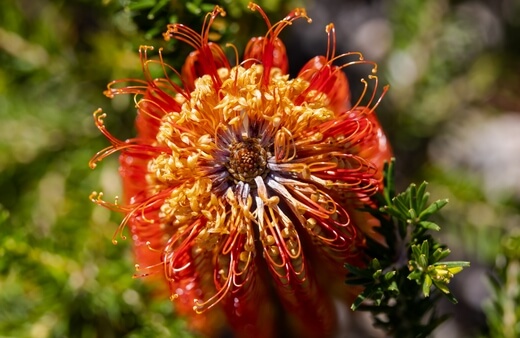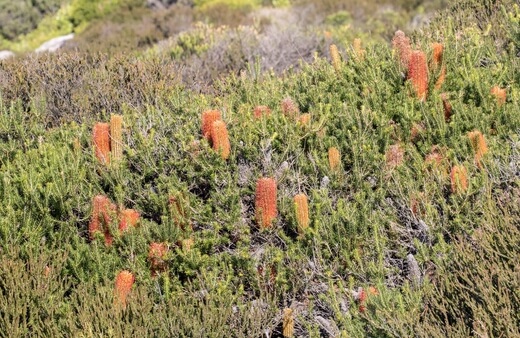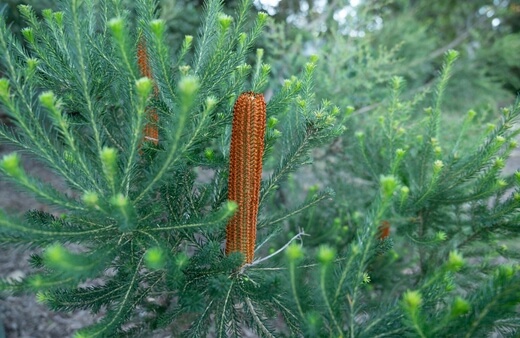I have always been a great admirer of our beloved banksias and the Banksia ericifolia is one of the most cultivated of its genus. Famed for its flame-like orange-to-red autumn inflorescences which contrast beautifully with its green fine-leaved heath-like foliage, this medium shrub can make for a fantastic ornamental addition to almost any Australian garden.
This iconic and very popular native plant is notorious for its prolific flowering and thick dense habit, boasting extremely striking large and long-lasting orange cylindrical flower spikes atop fine green foliage, all of which can add a colourfully lush and textured appeal to your outdoor spaces.
Here is everything you need to know to grow and care for this showy native shrub.
More...

Family: | Proteaceae |
|---|---|
Genus: | Banksia |
Species: | ericifolia |
Common Names: | Heath banksia, heath-leaved banksia, lantern banksia |
Location: | Outdoor |
Type: | Shrub |
Growth: | 2 to 5 metres tall, 2 to 3 metres wide |
Sun requirements: | Full sun to light shade |
Foliage Colour: | Green |
Flower Colour: | Reddish orange |
Flowering: | Spring to autumn |
Maintenance level: | Low |
Poisonous for pets: | Toxic to cats and dogs |
Getting to Know Banksia ericifolia
Being a very hardy, adapted and low-maintenance species, this plant is a great pick for any grower looking for an easy-to-grow native that can offer brilliant long-lasting displays of colourful blooms. Thanks to its autumn blooming, this shrub is also a vital source of nectar for many local birds, bees and other indigenous wildlife.
Botanically labelled Banksia ericifolia, the shrub is now well-known by its common names which include the heath banksia, heath-leaved banksia or lantern banksia. Part of the Proteaceae family, this plant is native to Australia, occurring largely in New South Wales across the eastern coast.
Thanks to its extensive adaptation, this shrub can be grown in most of our endemic climates and it can also tolerate most soils with good drainage. In cultivation, heath banksia will usually reach about 2 to 5 metres tall and 2 to 3 metres wide with a very fast-growing habit in good conditions.

Common landscaping applications include:
- Hedging and screening (See our guide on the best Australian native hedge plants)
- Feature planting
- Coastal gardening
- Gap filling in beds
- Native gardening
Special uses include:
- Banksia ericifolia will look fantastic planted alongside other native shrubs like grevilleas or lilly pillies.
- The large blooms will make for good cut flowers in floral arrangements.
- The famous cultivar, Banksia ‘Little Eric’, is the perfect substitute for smaller gardens.
Growing Different Types of Banksia ericifolia
Banksia ‘Little Eric’
Banksia ‘Little Eric’ only grows to about 1.5 m in height with a spreading habit. The best thing about this banksia is that I grew it in a shady area under a large tree that was growing in the house next door.
The roots from this tree ensured that the ground was always bone dry and despite this it always puts on a flowering display every winter and never shows any signs of stress. So if you’re after a plant to put in a dry shady area this might be a very good choice.
Banksia ‘Giant Candles’
There are also a few hybrids as well that are worth a mention. Banksia ‘Giant Candles’ is the most well known. A hybrid with B. Spinulosa this banksia gets its name from the long flowers it produces, up to 40 cm long.
The shrub itself grows up to 5 or 6 m and could nearly be classified as a small tree. I grew this in my last garden. It tends to grow reasonably fast and is covered in long orange flowers over winter.
Banksia ‘Yellow Wing’
Another Hybrid is called Banksia ‘Yellow Wing’, a hybrid between Banksia ‘Giant Candles’ and Banksia spinulosa var. collina. I’m currently growing this one in my garden at the moment but the growth has been slow. I’m not sure if this is due to the phosphorus in my soil or just the dry conditions.
I might try giving it some more water and we’ll see if it grows any faster. The other thing is that apart from the slow growth it hasn’t shown any signs of phosphorus toxicity whatsoever so it appears to be resistant to the effects of the phosphorus.


Get Your Free Guide:
Master Growing Australian Natives eBook
A Must Have Complete Guide for Every Australian Garden
Get Your Free Guide:
Master Growing Australian Natives eBook
A Must Have Complete Guide for Every Australian Garden
Banksia ‘Little Eric’ and Banksia ‘Giant Candles’ are the ones that I’ve had the most success with and would recommend them as starters but I’d be very interested to get some feedback on what other people have tried.
How to Grow Banksia ericifolia
Banksias can be reliably propagated by seed or cuttings. Seed-grown shrubs can take around 4 years to flower whereas cuttings will ensure faster flowering. Alternatively, buying a more established nursery plant is also always a good idea when it comes to our natives.
Best Conditions Planting and Growing for Banksia ericifolia
Thankfully these hardy native shrubs require only basic growing conditions to thrive and flower best. If you can provide your lantern banksia with similar conditions to these, you will enjoy an easy-going experience with your plant.
The ideal planting time is spring to summer.
Ideal Sun Exposure
Banksias thrive in sunny, sheltered garden positions. However, they can tolerate light shade and should still flower well. Try to position your banksia so that it gets a good chunk of full sun each day with some afternoon shade.
Use the Best Soil for Your Heath-Leaved Banksia
As mentioned, this shrub can tolerate a wide range of soil types so long as the mix is light and well-draining. Sandy soils are preferred with a slightly acidic pH level. Try to avoid alkaline heavy soils. (Check your soil with this 3-in-1 Soil, Light, PH and Moisture Tester).
Quick Planting Tips for Lantern Banksia
- If you’re concerned about the drainage in your garden bed's soil, mix some sand and perlite in before planting to ensure adequate drainage.
- Be sure that the entirety of the root ball is submerged in the soil when planting.
- Water well after planting and during early development.
Propagating Heath Banksia

Source: GardensOnline
Banksia ericifolia Propagation from Seeds
- Prepare seed trays or containers and fill them with a high-quality seed-raising mix that is very free draining.
- Sow seeds in spring by planting them lightly into the topsoil. Pour a little sand onto the top of the mix to slightly weigh the seeds down into the soil.
- Keep the soil moist at all times.
- Once germination has occurred and the first true leaves have appeared, you can transplant the seedlings into small pots filled with a quality potting mix for continued growth.
Propagating Heath Banksia Using Cuttings
- Take a healthy semi-hardwood stem cutting of around 25 cm long from a mature shrub.
- Place the cutting into rooting hormone and prepare a growing container filled with a high-quality potting mix. Mix in a little sand as well to ensure good drainage.
- Ideal temperatures for cuttings are between 20 to 25°C.
- Keep the soil moist while the cutting develops.
- After about 3 months, your cutting should be ready for transplantation into the garden.
How to Care for Banksia ericifolia
Once established, these shrubs will be tolerant to drought, frost and heat. During initial development, your banksia will appreciate some extra care and attention to ensure you have a healthy and happy parent plant.

Watering Heath Banksia
Banksias require regular water until being fully established which usually takes around 2 years. Water about twice a week during this stage. Extra water will also be needed during long and dry periods. Once established, water deeply about bi-monthly to maintain your plant.
Pruning Lantern Banksia
Prune regularly to maintain shape, keep your shrub neat and encourage flowering. It is best to frequently tip-prune banksias and avoid any hard pruning, this will also ensure you avoid any leggy or stunted growth. Snap off spent flowers as needed.
Mulching for Ideal Moisture
In summer, add an organic mulch around the root zone of your plant to help with moisture retention during the warmer months.
Fertiliser Needs
As this plant is part of the Proteaceae family, be careful not to use a fertiliser that is high in phosphorus as this can quickly kill your plant. Rather feed your banksia with a specially formulated organic native fertiliser once to twice a year for the best results.
Banksia ericifolia as a Bush Tucker
While this shrub cannot be used very extensively in the kitchen versus other bush tuckers, the nectar-rich flowers can be steeped in water to make a delicious and nutritious tea.
- Using a sharp and sterilised pair of secateurs, cut ripe banksia flowers straight from your shrub.
- Lightly rinse the flowers then soak them in cold water for a few hours.
- Place the soaking flowers in the fridge or a cool spot.
- When ready, drain the sweet water for drinking.
- Banksia tea contains vitamin C and other useful minerals.
Lantern Banksia Pests and Diseases to Look Out For
Being hardy native shrubs, these plants rarely struggle with any pests and disease issues if positioned correctly in your landscape and cared for properly.
Here are some problems you may run into in poor conditions:
Root Rot
If you notice signs of root rot, this should indicate that your soil is not draining well enough. Signs can include browning leaves and soggy roots. Allow your soil to dry out and then mix in some sand, perlite or other organic material like compost to help improve the overall drainage. Regularly and lightly aerating your soil will also certainly help.
Caterpillars
Caterpillars will usually only negatively affect developing banksias. If you have a larger established plant and notice a small amount of foliage being eaten, you needn’t panic. If you notice significant damage, especially on younger plants, spray your shrub with organic neem oil to reduce infestation.
Scale Insects
These small sap-sucking insects are usually located on the stems of your plant. Be sure to treat them as soon as you can to prevent sooty mould from forming. They can be reliably cleared by using an organic insecticide.
Phosphorus Poisoning
If you notice the leaves of your banksia are yellowing with brown tips or edges, this should indicate that your fertiliser is too phosphorus heavy or you may even be feeding too often. Be sure to use a fertiliser low in phosphorus and add an iron-inducing product to the soil to help rebalance the mix and reduce the phosphorus levels.
Banksia ericifolia Frequently Asked Questions

What is the lifespan of a banksia?
Usually, these hardy shrubs live for over 100 years in good conditions.
Is Banksia ericifolia evergreen?
Yes, this shrub along with its entire genus is evergreen.
Are banksia roots invasive?
Yes, the roots can become invasive and messy over time. It is best to plant any banksia away from water lines or paved areas.
Add Native Spectacle to Your Garden with Banksia ericifolia
This showy native shrub is a must-have addition to any native garden or any garden that needs a little extra colour and spectacle. Whether planted as a feature or as a screen, this plant will always impress with its long-lasting bright orange blooms and fine green foliage.
It will be easy for anyone to enjoy the fantastic pops of native colour and texture that Banksia ericifolia can offer in your outdoor spaces.
Published on November 29, 2022 by Nathan Schwartz
Last Updated on January 18, 2025




